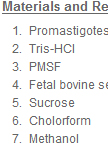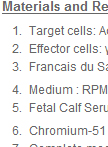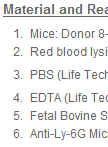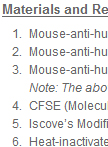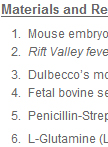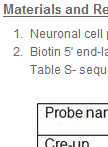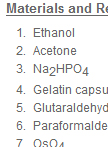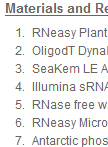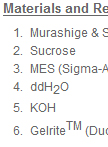Improve Research Reproducibility A Bio-protocol resource
- Protocols
- Articles and Issues
- About
- Become a Reviewer
Past Issue in 2012
Volume: 2, Issue: 23
Biochemistry
Glycophosphosphingolipid (GSPL) Purification Protocol
Glycosylated ceramide phosphorylinositol are present in many species of fungi and mushrooms and bacteria and parasitic organisms like leishmania. These are usually membrane raft associated and are not easily extracted by conventional methodologies. This extraction method gives higher yield of the glycolipid. Glycosphingolipids are usually associated with the detergent resistance membrane rafts. They are difficult to be extracted by neutral solvents from rigid promastigote cell wall with neutral or less polar solvents. For more polar phospholipids, more polar solvents are essential. Ammonia is used to extract phosphatidylinositols.
Immunology
Standard 4-hours Chromium-51 (51Cr) Release Assay
51Cr-release assays are commonly used for the precise and accurate quantification of cytotoxicity, particularly in the study of tumor cytolysis. This test has the advantage of requiring only very few cells.
Adoptive Transfer of Isolated Bone Marrow Neutrophils
Adoptive transfer experiments of specific cell populations are widely used methods to assess the role of the injected population on an ongoing process. In the last years, new and unprecedented roles in the regulation of immune responses have been reported for neutrophils. The following protocol is to be used to isolate neutrophils from bone marrow and to inject them in an appropriate host to test the role of neutrophils during infection, inflammation or other pathological conditions.
Ex vivo Human Antigen-specific T Cell Proliferation and Degranulation
Proliferative capacity and degranulation are important features of antigen-specific CD8+ T cells. By combining tetramer staining with a CFSE staining, we were able to enumerate the total number of antigen-specific T cells, as well as their number of divisions upon antigen-specific stimulation during a week. In addition, we performed restimulation of these cells, to analyze their ability to secrete cytolytic granules, visualized by CD107a staining.
Viral Immunofluorescence with Rift Valley Fever Virus Infected MEFs in a 96 Well Plate
Immunofluorescence is a method to detect viral infection in multiple types of host cells. This procedure can be adapted for both high-throughput and low-throughput assays for any virus for which there are antibodies available. Time of infection and virus multiplicity of infection (MOI) vary and should be optimized for each virus and host cell type. Here we give an example of viral immunofluorescence in a 96 well plate with a Rift Valley fever virus (RVFV, strain MP12) infection in mouse embryonic fibroblasts (MEF).
Neuroscience
A Protocol for Electrophoretic Mobility Shift Assay (EMSA) from Primary Neuron
The interaction of transcriptional or co-transcriptional factors with DNA is crucial for changes of neuronal gene expression during normal brain development as well as neurodegeneration. The electrophoretic mobility shift assay (EMSA) is a very powerful technique for studying changes of neuronal gene expression and determining protein: DNA interactions. EMSA can be used qualitatively to identify specific transcriptional or co-transcriptional factors in brain crude lysates or primary neurons and, in conjunction with mutagenesis, to identify the important binding sequences within a given gene. An advantage of studying protein: DNA interaction by an electrophoretic assay provides a better understanding of epigenetic changes during normal brain development and neurodegenerative process.
Plant Science
Plastic Embedding and Sectioning of Plant Tissues
Plastic (resin) embedding provides exclusively improvements to cellular definition compared to paraffin embedding. The combination of strongly cross-linking paraformaldehyde with glutaraldehyde and post fixed with OsO4 is the fixative of choice for high-resolution light microscopy and electron microscopy. For this reason, this method is an ideal tool for visualizing plant cellular morphology and phenotype.
Preparation of cDNA Library for dRNA-seq
microRNAs (miRNAs) are ubiquitous regulators of gene expression in eukaryotic organisms, which guide Argonaute proteins (AGO) to cleave target mRNA or inhibit its translation based on sequence complementarity. In plants, miRNA directed cleavage occurs on the target mRNA at about 10 to 11 nucleotide (nt) up stream to the site where the 5’ end of miRNA binds. Sequencing of the miRNA directed cleavage products (degradome) is widely employed as a way to both verify bioinformatic predictions of miRNA mediated regulation and identify novel targets of known miRNAs. Here we describe a protocol for preparation of degradome RNA complementary DNA library for high-through-put sequencing (dRNA-seq) using Illumina GA II sequencing platform, which is currently most popular and cost-effective. Using this protocol we successfully generated three dRNA-seq libraries using three solanaceae plants, including tobacco, tomato and potato. Although this protocol was developed with single-plexed adapter, it should be able to generate multiplexed libraries by replacing the 3’ adapter with multiplexing compatible 3’ adapter and replacing the PCR primer with indexed primers.
Grafting of Potato Plants
Grafting is a very useful technique for testing the transmission of long-distance signals in plants and is used in agriculture and gardening for different purposes. This protocol, based on a previously published one (Jackson et al., 1998), describes a grafting method for potato plants, which has successfully been used to test the transmission of tuber-inducing signals (Martin et al., 2009; González-Schain et al., 2012). We describe first the procedures for plant growth and then the grafting procedure. Although this method has been used for grafting plants that were initially grown in vitro, it should work as well with plants grown from tubers in soil. This protocol probably works well for other plant species, with small modifications.


